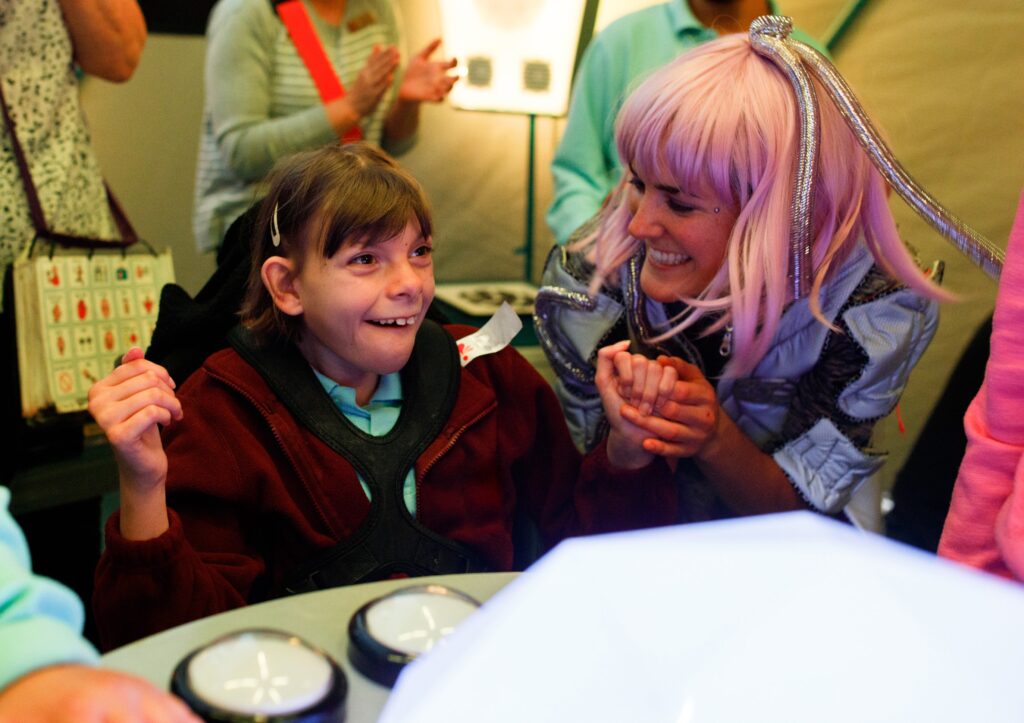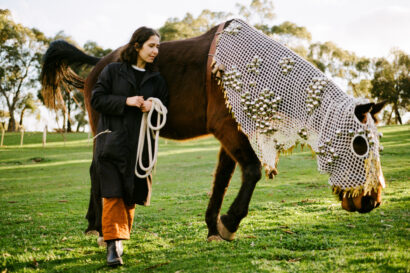The co-artistic directors of Sensorium Theatre respond to Seesaw’s critique of ‘Whoosh!’ by sharing their experiences creating theatre for neurodiverse children.
Sensorium Theatre on the challenges of creating inclusive theatre
26 September 2020
- Reading time • 9 minutesTheatre
More like this
- Just what the doctor ordered
- Lifting the weight of the world
- Gentle touch guides lunar landing
Sensorium Theatre co-artistic directors Michelle Hovane and Francis Italiano have written a response to Seesaw’s review of Whoosh!, written by disabled and autistic reviewer Patrick Gunasekera.
As the Co-Artistic Directors of Sensorium Theatre we read your review of Whoosh! with sadness and regret. Not because the review is unfavourable, the company is certainly open to critical feedback and prepared to re-calibrate accordingly.
We are truly sorry that your experience was not positive and evoked bad feelings, leaving you “personally on the brink of a sensory meltdown”. We acknowledge the validity of your response and its expression.
Whilst it stings, it is always good to be called to account and reflect on the effect that our work has on an audience member. It is something that is a strong part of our dramaturgy and how we evolve our work.
We would welcome further conversation with you about your experience. We would also welcome conversation about that particular performance and the attending audience group. It’s worth noting that we did engage with the group post show and feedback from our target audience and their circle of care was in fact overwhelmingly positive.
Whoosh! was developed over 4 years through a process of brainstorming, testing, piloting, building, and playing with many young people with all sorts of disabilities – including those with complex and multiple disabilities, intellectual and physical disabilities and those on the autism spectrum. We worked with students from our partner school (and home base) Kenwick School as well as Carson Street, Kalamunda, Castlereagh, Malibu and Joondalup education support schools. We kept refining the performance, design, sound, and technical elements based on audience responses.

Whoosh! has then toured to 5 different regional WA venues, spending a week in each community, as well as The Sydney Opera House and the Arts Centre Melbourne.
In that time, we had all sorts of missions with all sorts of children and young people, mostly neurodivergent. The feedback has been overwhelmingly positive – both from the young people themselves and in some cases from their circle of care. As performers we receive this feedback instantaneously and viscerally in both verbal and non-verbal communication from our audience members during and post show. It is also something we learn to trust our intuition about – we know when a show has landed and when it has missed the mark.
Schools and parents who know the individual children in our audiences have consistently followed up after performances with extremely positive feedback. We have gathered a body of evidence of this impact through our Culture Counts surveys.
It is always a challenge when encountering school groups of children with disabilities/access needs to navigate the additional layer of adults and the culture of a particular school or group to be met. It is always a dance between engaging the partnership of the adult educators/carers, acknowledging their expertise and intimate knowledge of the children and pushing the boundaries of their expectations of what is OK/expected/acceptable.
Sensorium Theatre does share guidelines for enjoying the performance with the attending adults, including specifically stating that “Children are encouraged to enjoy the performance in their own way – there is no wrong way to join in.”
Sensorium would never stop an audience member from moving or verbalising in any way they want – we have countless stories of shows performed with children vocalising centre stage throughout, or closely shadowing or hugging their favourite characters mid-performance! The only exception to this would be if the audience member’s behaviour was endangering self or others in which case we would enlist the help of the responsible adult to bring the audience member to safety.
It is reasonable to make the point that staff from school groups on excursions often seek to control and manage children’s spontaneous expressions and behaviours where they perceive those expressions and behaviours to be inappropriate. This also applies to neurotypical children on a school excursion and in general, is part of education culture. It is something that artists often seek to loosen or challenge – but our capacity to do that within a performance is limited as it is the staff who hold the duty of care towards their students. Patrick conflates the actions of the education staff with the actions of our performers and we believe it is important to make this distinction.
We play a lot in our theatre shows between allowing individuals to navigate their own path through a performance and finding moments of collective experience which we believe are integral to the communal experience of theatre. This is part of what we believe access and inclusion to performance is. Whoosh!’s many invitations to audience members to play along and join in often elicit unexpectedly willing responses.
Whilst it stings, it is always good to be called to account and reflect on the effect that our work has on an audience member. It is something that is a strong part of our dramaturgy and how we evolve our work.
We also spend quite some time developing our somatic intelligence to both be fully present and to increase our capacity to read our audience. As with most participatory and proximal performance we are making judgement calls about how and where to engage, touch, make eye contact with audience members. Where we perceive our approach is “unwanted” we back away. We invite but do not insist. We do not believe that we are contributing to a culture of expectations of conformity. Having acknowledged that this is not our belief – we will continue to re-examine our interactions with an additional critical lens in place.
Of course, we agree that Whoosh! is not for ALL neurodivergent children – it is a highly stimulating and sensorially rich show. We have found that some children on the spectrum actually love this aspect of the work. It would be well-nigh impossible to create a show that was suitable for all neurodivergent children. In fact, we are yet to make a work specifically for children on the autism spectrum, although this is part of our artistic plan in the next 3 years.
We worked with Awesome Festival on their ASD guide to list the types of experiences and triggers that audience members may encounter in a performance of Whoosh!, so that parents and carers can make informed choices. When audiences book they are sent a simple questionnaire asking for their age, if they have any allergies, and any additional information which our performers may need to enhance their experience of the show. We were not given prior notice of Patrick’s attendance and therefore did not have the opportunity to follow our usual booking protocol. If we had been aware of Patrick’s access needs, we could have then pointed out Patrick’s options to take sensory breaks during the show in the chill out zone at Ground Control or watch from outside the spaceship on the live action monitor, which may have assisted them to avoid sensory overload. We also recommend that audience members access our free APP to prepare them for some of the specific events and triggers of the show.
Whilst creating exciting theatre for children with disabilities has been our primary aim, we might also add that an immediate strategic goal of Sensorium is to expand our performance ensemble to be more culturally diverse and include performers with disabilities. We have taken a number of steps towards this goal including creating pathways for artists with disabilities.
Your critical and non-complimentary review is perhaps an encouraging sign of the evolution of this field and the increasing interrogation of access and inclusion within the performing arts.
Michelle Hovane and Francis Italiano, Co-Artistic Directors of Sensorium Theatre
25 September 2020
Read Patrick Gunasekera’s review of Whoosh!
Whoosh! runs from 29 Sept – 2 Oct as part of Awesome Festival.
Pictured top: Cast members and children interact with the sensory aspects of Whoosh! Photo Christophe Canato
Like what you're reading? Support Seesaw.






